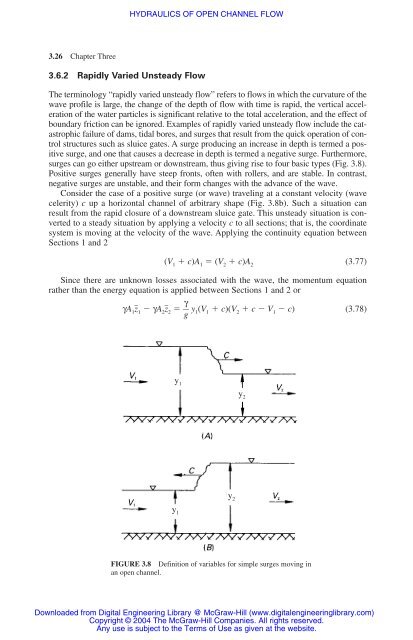chapter 3 hydraulics of open channel flow
chapter 3 hydraulics of open channel flow
chapter 3 hydraulics of open channel flow
You also want an ePaper? Increase the reach of your titles
YUMPU automatically turns print PDFs into web optimized ePapers that Google loves.
3.26 Chapter Three<br />
HYDRAULICS OF OPEN CHANNEL FLOW<br />
3.6.2 Rapidly Varied Unsteady Flow<br />
The terminology “rapidly varied unsteady <strong>flow</strong>” refers to <strong>flow</strong>s in which the curvature <strong>of</strong> the<br />
wave pr<strong>of</strong>ile is large, the change <strong>of</strong> the depth <strong>of</strong> <strong>flow</strong> with time is rapid, the vertical acceleration<br />
<strong>of</strong> the water particles is significant relative to the total acceleration, and the effect <strong>of</strong><br />
boundary friction can be ignored. Examples <strong>of</strong> rapidly varied unsteady <strong>flow</strong> include the catastrophic<br />
failure <strong>of</strong> dams, tidal bores, and surges that result from the quick operation <strong>of</strong> control<br />
structures such as sluice gates. A surge producing an increase in depth is termed a positive<br />
surge, and one that causes a decrease in depth is termed a negative surge. Furthermore,<br />
surges can go either upstream or downstream, thus giving rise to four basic types (Fig. 3.8).<br />
Positive surges generally have steep fronts, <strong>of</strong>ten with rollers, and are stable. In contrast,<br />
negative surges are unstable, and their form changes with the advance <strong>of</strong> the wave.<br />
Consider the case <strong>of</strong> a positive surge (or wave) traveling at a constant velocity (wave<br />
celerity) c up a horizontal <strong>channel</strong> <strong>of</strong> arbitrary shape (Fig. 3.8b). Such a situation can<br />
result from the rapid closure <strong>of</strong> a downstream sluice gate. This unsteady situation is converted<br />
to a steady situation by applying a velocity c to all sections; that is, the coordinate<br />
system is moving at the velocity <strong>of</strong> the wave. Applying the continuity equation between<br />
Sections 1 and 2<br />
(V 1 � c)A 1 � (V 2 � c)A 2<br />
(3.77)<br />
Since there are unknown losses associated with the wave, the momentum equation<br />
rather than the energy equation is applied between Sections 1 and 2 or<br />
γ<br />
γA1z�1 � γA2z�2 � �� y1 (V1 � c)(V2 � c � V1 � c) (3.78)<br />
g<br />
y 1<br />
y 1<br />
FIGURE 3.8 Definition <strong>of</strong> variables for simple surges moving in<br />
an <strong>open</strong> <strong>channel</strong>.<br />
Downloaded from Digital Engineering Library @ McGraw-Hill (www.digitalengineeringlibrary.com)<br />
Copyright © 2004 The McGraw-Hill Companies. All rights reserved.<br />
Any use is subject to the Terms <strong>of</strong> Use as given at the website.<br />
y 2<br />
y 2

















